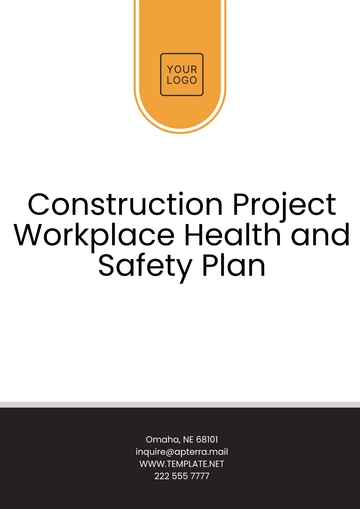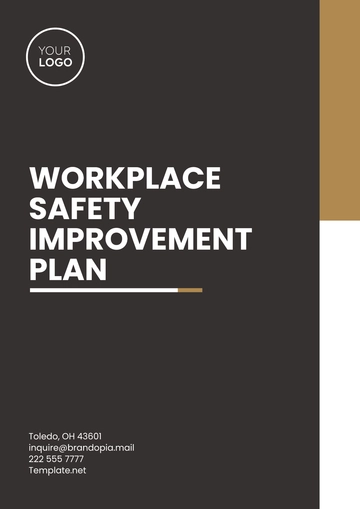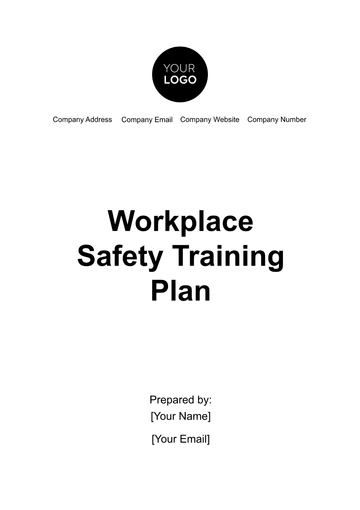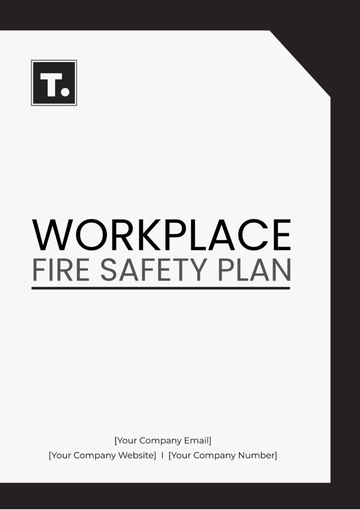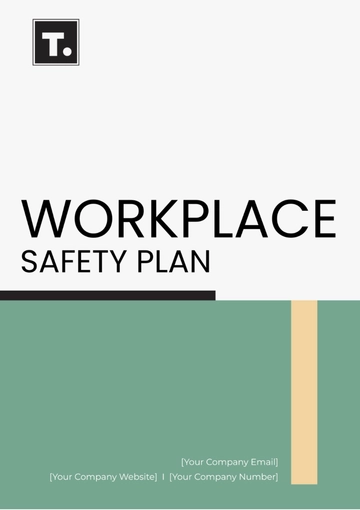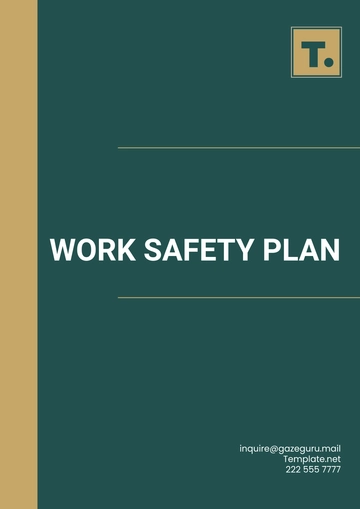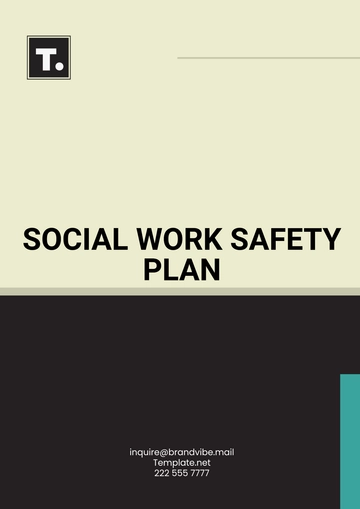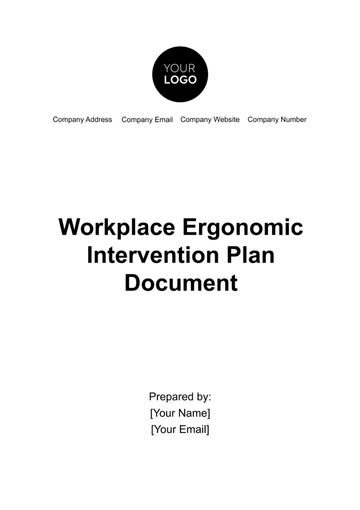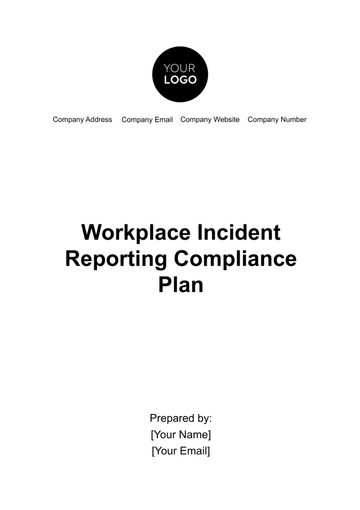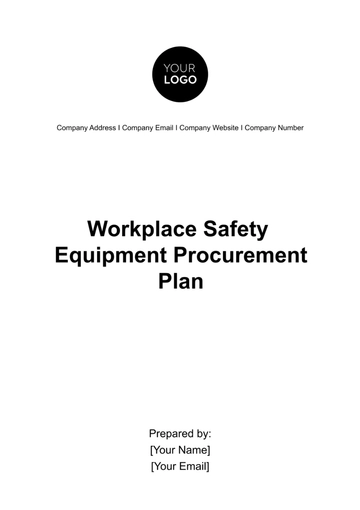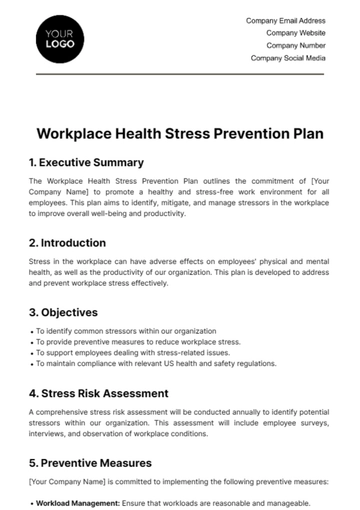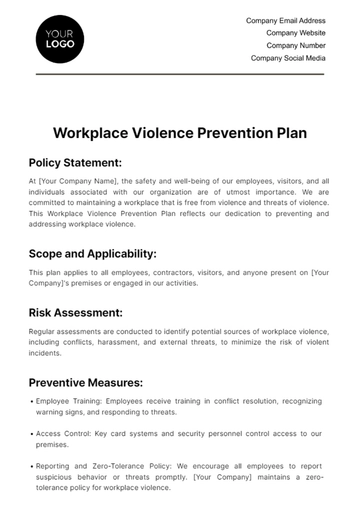Free Workplace Incident Reporting Compliance Plan
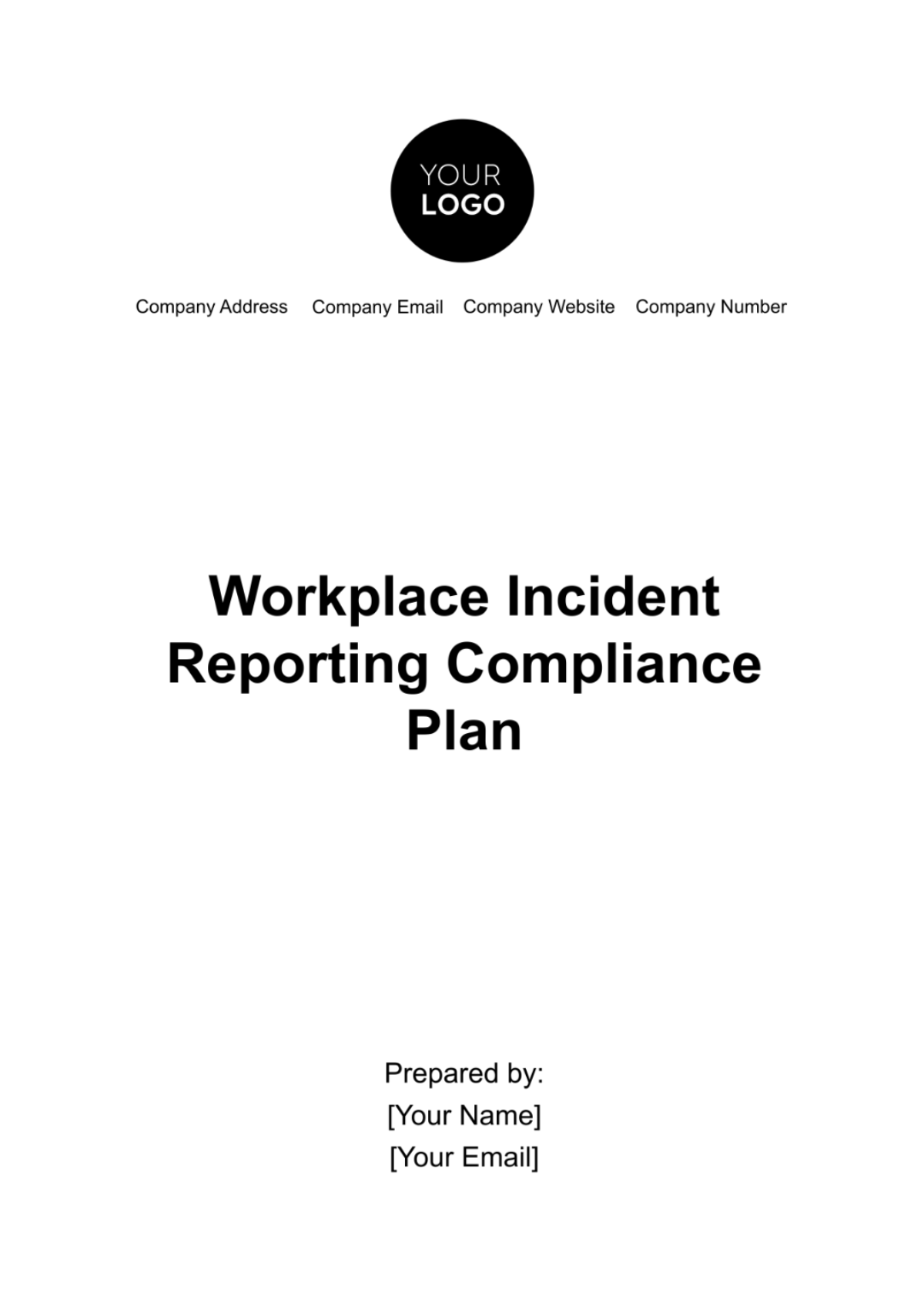
Compliance Plan
Introduction
A. Purpose
The Enhanced Workplace Incident Reporting Compliance Plan (E-WIRCP) of [Your Company Name] aims to establish a comprehensive and standardized procedure for reporting, recording, and responding to workplace incidents. This plan is critical for ensuring compliance with national and local legislation, notably under the Occupational Safety and Health Act (OSHA), and in promoting a safe and healthy working environment for all employees, contractors, and visitors.
The fundamental purpose of this document is to:
Establish clear procedures for reporting workplace incidents.
Define roles and responsibilities in the incident reporting process.
Ensure a swift and effective response to workplace incidents.
Facilitate compliance with legal and regulatory requirements.
Create a framework for incident investigation and corrective action.
Promote a culture of safety and awareness within the organization.
B. Scope
This plan covers all operations and locations under [Your Company Name], including the headquarters in New York, manufacturing plants, remote offices, and any temporary work sites. It applies to all personnel, including full-time and part-time employees, contractors, and temporary staff, as well as visitors to any of our premises.
C. Definitions
Incident: Any occurrence that disrupts or has the potential to disrupt workplace safety, health, or well-being. This includes but is not limited to accidents, injuries, health crises, and property damage.
Near Miss: A situation where an incident could have occurred but did not, either by chance or through timely intervention. Near misses are critical for understanding potential risks and preventing future incidents.
First Aid: The immediate and temporary care provided to an individual suffering from a minor injury or illness. This term also extends to emergency care given in more serious situations until professional medical help arrives.
Reportable Incident: An incident that falls under the criteria set by OSHA or other relevant authorities, requiring formal documentation and reporting.
Compliance Obligations
A. Legal Requirements
To ensure compliance with the Occupational Safety and Health Act (OSHA) and New York State Labor Law, [Your Company Name] has established the following legal obligations:
Jurisdiction | Regulation | Description |
Federal | Occupational Safety and Health Act (OSHA) | Regulations for workplace health and safety and reporting requirements |
New York | New York State Labor Law | State-specific workplace safety standards and reporting protocols |
Compliance with these regulations involves:
Timely reporting of specific types of incidents to the appropriate regulatory bodies.
Maintaining accurate and detailed records of all workplace incidents, including near misses.
Implementing corrective measures as mandated by investigation findings.
Ensuring that all employees are aware of their rights and responsibilities under these regulations.
B. Internal Policies
[Your Company Name] has established the following internal policies to supplement legal requirements and support the company's commitment to a safe and healthy workplace:
Policy Document | Description |
Zenith Health and Safety Policy | This policy outlines the company’s commitment to maintaining a safe workplace. It includes the provision of necessary safety equipment, regular safety training, and protocols for responding to safety incidents. |
Emergency Response Policy | This document details the procedures for responding to various emergencies, including fire, medical emergencies, and natural disasters. It outlines the roles and responsibilities of designated emergency response teams. |
Incident Reporting and Investigation Policy | This policy provides a step-by-step guide on how to report and investigate workplace incidents. It covers the documentation requirements, investigation procedures, and follow-up actions to prevent recurrence. |
Worker Compensation and Rehabilitation Policy | This policy outlines the processes for handling worker compensation claims and the rehabilitation of employees who have suffered workplace injuries. It ensures compliance with legal requirements and provides support for affected employees. |
Incident Reporting Procedures
The incident reporting procedures are designed to ensure a systematic approach to handling workplace incidents, from immediate response to final resolution.
A. Immediate Action
When an incident occurs, the following immediate actions must be taken:
1. Ensure Safety
The priority is to ensure the safety of all individuals involved. This may involve evacuating the area, administering first aid, or isolating hazards.
2. Notify Supervisor
The incident must be reported immediately to the immediate supervisor or designated safety officer. If the supervisor is not available, the next level of management must be informed.
B. Reporting Process
The reporting process is a critical component in managing workplace incidents effectively:
Complete Incident Report Form
The involved employee or a witness must complete an Incident Report Form within 24 hours of the incident. This form is available in both paper format and electronically on the company intranet.
Investigation
The Health and Safety Officer, along with a designated investigation team, will conduct a thorough investigation of the incident. This team may include supervisors, technical experts, and a representative from the Human Resources department.
Documentation
All documentation related to the incident, including the Incident Report Form, witness statements, and investigation findings, must be maintained for a minimum of 5 years. This documentation is crucial for legal compliance, identifying trends, and preventing future incidents.
Roles and Responsibilities
A clear definition of roles and responsibilities is crucial for the effective implementation of the E-WIRCP.
Employees: All employees are required to report any incidents or near misses immediately to their supervisor or the safety officer. Employees are also expected to cooperate in the investigation process and adhere to safety protocols.
Supervisors: Supervisors are responsible for ensuring that the incident report is completed accurately and promptly. They are also involved in the initial response and coordination of the investigation process.
Health and Safety Officer (HSO): The HSO oversees the entire incident reporting and investigation process. They are responsible for ensuring compliance with legal requirements, coordinating the investigation, and liaising with external health and safety auditors.
Human Resources: The HR department manages communication with affected employees and their families, handles any workers' compensation claims, and ensures that employees receive appropriate support and rehabilitation.
Management: Senior management is responsible for providing the necessary resources for the effective implementation of the E-WIRCP. They must also ensure that all staff are aware of their responsibilities and that a culture of safety is promoted throughout the organization.
Incident Response and Post-Incident Support
The Incident Response and Post-Incident Support section is a crucial addition to the Enhanced Workplace Incident Reporting Compliance Plan. This section outlines the steps taken immediately following an incident and the support mechanisms in place for affected employees.
A. Incident Response Team
An Incident Response Team (IRT) is a designated group responsible for managing the immediate aftermath of an incident. The team's composition may vary depending on the nature and severity of the incident but typically includes:
A team leader (usually the Health and Safety Officer or a senior manager).
A representative from the Human Resources department.
First aid trained personnel.
Technical experts relevant to the incident (e.g., equipment specialists).
A communications officer (for managing internal and external communication).
B. Immediate Response Procedures
Upon the occurrence of an incident, the IRT will:
Assess the Situation: Quickly evaluate the severity and potential impact of the incident.
Secure the Area: Ensure that the incident site is safe and secure to prevent further harm or damage.
Provide Immediate Care: Administer first aid or emergency care as needed and coordinate with emergency services if necessary.
Gather Information: Collect initial information about the incident, which will be crucial for the subsequent investigation.
C. Post-Incident Support
Following the immediate response, the focus shifts to supporting the affected employees and preventing the recurrence of similar incidents:
Employee Assistance
Offer counseling services, medical care, and support to the affected employees. This also includes facilitating any necessary leave and rehabilitation.
Communication
Keep all stakeholders, including employees, management, and, if necessary, external parties, informed about the incident and the company's response.
Review and Follow-Up
Conduct a thorough review of the incident to identify the root causes and implement corrective actions. This may involve revising existing policies, enhancing training programs, or introducing new safety measures.
Documentation and Reporting
Complete all necessary documentation and reporting, both for internal records and compliance with legal obligations.
Long-Term Support
In cases of serious incidents, provide long-term support and monitoring of affected employees, including regular check-ins and adjustments to work arrangements if needed.
D. Training for the Incident Response Team
The members of the IRT undergo specialized training to equip them with the skills and knowledge necessary to effectively manage workplace incidents. This training includes:
Crisis management and communication.
Advanced first aid and emergency response.
Stress management and psychological first aid.
Legal and compliance aspects of incident response.
Training and Awareness
Effective training and awareness programs are essential components of the E-WIRCP.
A. Training Requirements
1. Initial Training
All new employees must undergo safety training within their first month of employment. This training covers incident reporting procedures, emergency response protocols, and basic first aid.
2. Annual Refresher Training
All employees must participate in annual refresher training to stay updated on any changes in policies, regulations, and best practices.
B. Awareness Programs
Monthly Safety Meetings
These meetings are held to discuss recent incidents, near misses, and any updates to safety procedures. They also serve as a platform for employees to share concerns and suggestions related to workplace safety.
Quarterly Newsletters
The company publishes a quarterly safety newsletter that shares safety tips, incident statistics, and success stories regarding safety improvements. This newsletter is distributed electronically to all employees and is also available on the company intranet.
Monitoring and Review
Regular monitoring and review of the E-WIRCP are critical for its success and continuous improvement.
A. Incident Tracking
Digital Incident Tracking System
A comprehensive digital system is used to record and analyze incident trends. This system allows for the identification of patterns and areas requiring attention.
Management Reports
Regular reports are generated from the incident tracking system and presented to management. These reports include statistics on the number and types of incidents, investigation outcomes, and status of corrective actions.
B. Annual Review
Audit of the E-WIRCP
An annual audit is conducted to assess the effectiveness of the plan. This audit is performed by an internal audit team or an external consultant.
Plan Amendments
Based on the audit findings and any changes in legislation or operational changes within the company, the E-WIRCP is updated to maintain its relevance and effectiveness.
- 100% Customizable, free editor
- Access 1 Million+ Templates, photo’s & graphics
- Download or share as a template
- Click and replace photos, graphics, text, backgrounds
- Resize, crop, AI write & more
- Access advanced editor
Introducing the Workplace Incident Reporting Compliance Plan Template from Template.net! This meticulously crafted resource offers an editable and customizable solution to streamline incident reporting procedures. Empower your team with this AI Editor Tool-enabled template, ensuring seamless compliance and efficient response to workplace incidents. Boost safety measures effortlessly with this essential resource.
You may also like
- Finance Plan
- Construction Plan
- Sales Plan
- Development Plan
- Career Plan
- Budget Plan
- HR Plan
- Education Plan
- Transition Plan
- Work Plan
- Training Plan
- Communication Plan
- Operation Plan
- Health And Safety Plan
- Strategy Plan
- Professional Development Plan
- Advertising Plan
- Risk Management Plan
- Restaurant Plan
- School Plan
- Nursing Home Patient Care Plan
- Nursing Care Plan
- Plan Event
- Startup Plan
- Social Media Plan
- Staffing Plan
- Annual Plan
- Content Plan
- Payment Plan
- Implementation Plan
- Hotel Plan
- Workout Plan
- Accounting Plan
- Campaign Plan
- Essay Plan
- 30 60 90 Day Plan
- Research Plan
- Recruitment Plan
- 90 Day Plan
- Quarterly Plan
- Emergency Plan
- 5 Year Plan
- Gym Plan
- Personal Plan
- IT and Software Plan
- Treatment Plan
- Real Estate Plan
- Law Firm Plan
- Healthcare Plan
- Improvement Plan
- Media Plan
- 5 Year Business Plan
- Learning Plan
- Marketing Campaign Plan
- Travel Agency Plan
- Cleaning Services Plan
- Interior Design Plan
- Performance Plan
- PR Plan
- Birth Plan
- Life Plan
- SEO Plan
- Disaster Recovery Plan
- Continuity Plan
- Launch Plan
- Legal Plan
- Behavior Plan
- Performance Improvement Plan
- Salon Plan
- Security Plan
- Security Management Plan
- Employee Development Plan
- Quality Plan
- Service Improvement Plan
- Growth Plan
- Incident Response Plan
- Basketball Plan
- Emergency Action Plan
- Product Launch Plan
- Spa Plan
- Employee Training Plan
- Data Analysis Plan
- Employee Action Plan
- Territory Plan
- Audit Plan
- Classroom Plan
- Activity Plan
- Parenting Plan
- Care Plan
- Project Execution Plan
- Exercise Plan
- Internship Plan
- Software Development Plan
- Continuous Improvement Plan
- Leave Plan
- 90 Day Sales Plan
- Advertising Agency Plan
- Employee Transition Plan
- Smart Action Plan
- Workplace Safety Plan
- Behavior Change Plan
- Contingency Plan
- Continuity of Operations Plan
- Health Plan
- Quality Control Plan
- Self Plan
- Sports Development Plan
- Change Management Plan
- Ecommerce Plan
- Personal Financial Plan
- Process Improvement Plan
- 30-60-90 Day Sales Plan
- Crisis Management Plan
- Engagement Plan
- Execution Plan
- Pandemic Plan
- Quality Assurance Plan
- Service Continuity Plan
- Agile Project Plan
- Fundraising Plan
- Job Transition Plan
- Asset Maintenance Plan
- Maintenance Plan
- Software Test Plan
- Staff Training and Development Plan
- 3 Year Plan
- Brand Activation Plan
- Release Plan
- Resource Plan
- Risk Mitigation Plan
- Teacher Plan
- 30 60 90 Day Plan for New Manager
- Food Safety Plan
- Food Truck Plan
- Hiring Plan
- Quality Management Plan
- Wellness Plan
- Behavior Intervention Plan
- Bonus Plan
- Investment Plan
- Maternity Leave Plan
- Pandemic Response Plan
- Succession Planning
- Coaching Plan
- Configuration Management Plan
- Remote Work Plan
- Self Care Plan
- Teaching Plan
- 100-Day Plan
- HACCP Plan
- Student Plan
- Sustainability Plan
- 30 60 90 Day Plan for Interview
- Access Plan
- Site Specific Safety Plan
